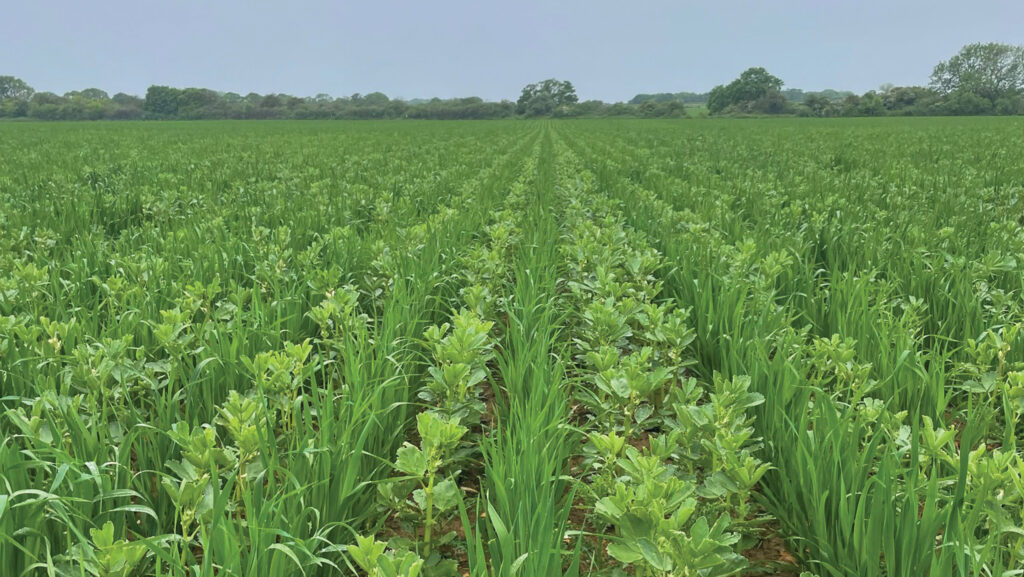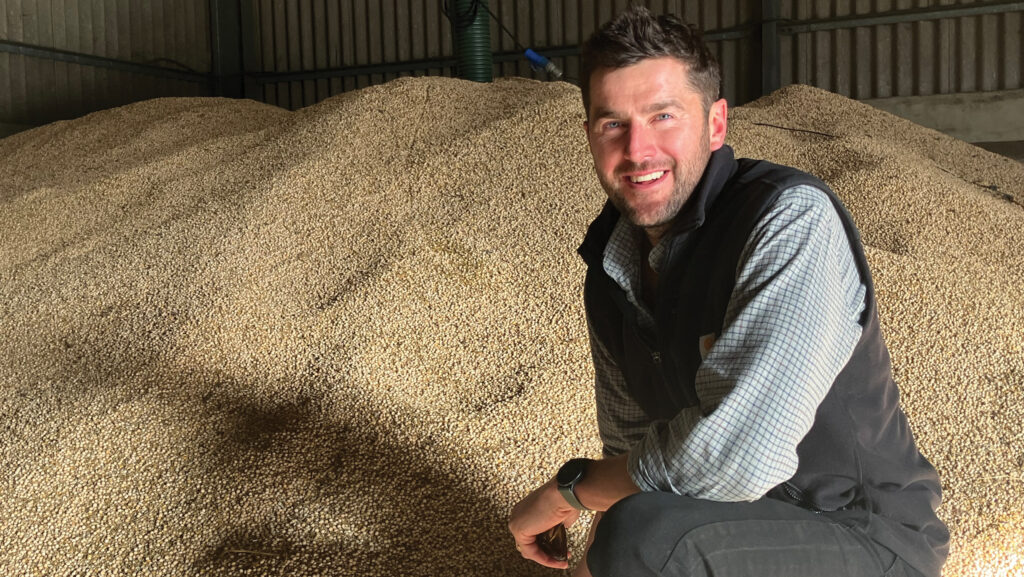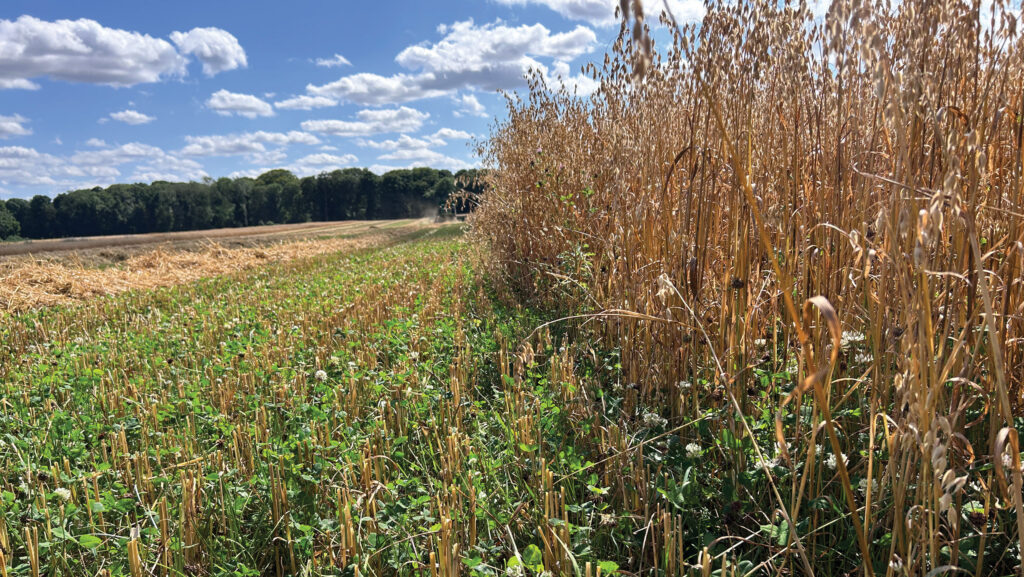How an organic estate hits £1,000/ha gross margins
 Beans and oats © Matt England
Beans and oats © Matt England Farming soils with an 80% sand content is no easy task, but thanks to a rotation rejig and organic conversion, the Fring Estate in Norfolk is targeting £1,000/ha gross margins.
Contrary to most UK arable farms, where winter wheat makes up the mainstay of the rotation, estate manager Matt England says such sandy soils cannot support the large nutrient demands of wheat.
“Instead, our rotation focuses on crops which are effective nutrient scavengers, such as oats and rye. Nitrogen and water are the estate’s most limiting resources, so since converting to organic in 2021, bicropping and integrating livestock are a big focus,” says Matt.
Ultimately, he aims to have all crops bicropped on the estate in the next five years.
See also: Video: Sugar beet harvest 2024 starts with highs of 100t/ha

Matt England © MAG/Emma Gillbard
Hefty gross margins
Last year’s intercropped winter beans and oats are expected to achieve a hefty gross margin of £1,149/ha, while the spring barley and yellow peas for human consumption were higher at £1,698/ha. Intercropped yields of the beans and oats achieved 5.4t/ha, while the barley and peas were 4.1t/ha.
“There is a huge industry focus on the benefits of multispecies cover crops, but why are we not focusing on multispecies cash crops?,” he says.
“Different crop species’ nutrient, water, and light demands peak at different times. Therefore, by growing a range of crops together, peak demands will differ and so growth is enhanced,” he says.
Another major change at the estate has been taking the most marginal land, which Matt describes as “fields of bottomless sand”, out of cereal production and into stewardship.
The estate farms 1,100ha of which half is down to environmental options, with four Mid Tier Countryside Stewardship agreements and three Sustainable Farming Incentive (SFI) schemes live.
This includes a farm on the Sandringham estate comprising a largely historic heathland. Fields which previously grew marginable winter barley yields of 5t/ha have been returned to nature.
“We now have a mix of flower-rich grasslands, bumble bird mixes, cultivated plots for arable plants and bird food which is giving us a better return. It’s almost like a safari park with the amount of wildlife,” says Matt.
Wheat makes a return
Cropping now consists of three years of herbal leys, winter oats, spring barley, linseed, rye, peas and beans, with some destined for the premium seed markets.
“I target a £1,000/ha gross margin, but most crops tend to be around £700-£800, depending on the year,” he says.
Previously, the rotation was based on sugar beet, winter and spring barley, stubble turnips and cocksfoot grass seed.
Winter wheat is not usually grown on the estate, but a wheat and bean intercrop established this autumn is about to change that.
“We are growing a blend of Group 2 winter wheats consisting of Mayflower, Extase and Nelson, with a crop of winter beans. We’re aiming for milling with 11%-12% protein content,” he says. This is something Matt wouldn’t have considered if it wasn’t for intercropping.
A range of new bicrops including vetch and linseed, as well as a trio of beans, oats and linseed, are also being grown.
“Organic linseed is a good earner for us, paying £1,000/t. It has low nutrient demands, with yields of 1.4t/ha. We’re now growing it alongside a legume to see if we can boost yields further.”
“The beauty of bicropping is that it takes the risk out of growing legumes on light soils. If one crop fails, you still have another option,” he notes.
Crops are separated with a 1950s Turners cleaner which is kitted out with three different sieves, capable of separating 1-2t/hour.
With yield increases of 10-20%, it’s not long before the cost of a seed separator is justified. Matt is looking to upgrade the seed dressing model as the intercropping area is scaled up.
Pigs in the rotation
The estate is working closely with an organic outdoor pig farmer rotating 90ha of pigs around the arable land each year, adding vital nutrients to soils and providing extra income.
However, such sandy soils can readily loose nutrients, so getting green cover in the form of cover crops on the land to capture nutrients as soon as the pigs are off is essential. The wallows are levelled-off with a cultivator and the cover crop is planted, before being ploughed-in and returning to arable.
The next mission is working with a local organic beef farmer to integrate a suckler herd onto the estate’s herbal leys, which will add further cash and manure to the business.
Crop management
The plough is the main tool for weed control at the Fring Estate, but bicropping is proving effective to suppress weeds.
“There is a huge difference in the weed burden in the bicropped areas, versus monocrop legumes with considerably less fat hen and thistles.
“Whether it is controlled through physical competitiveness and greater tillering of the cereals, or via allelopathic effects, there is a stark difference,” says Matt.
Disease is controlled through the power of nutrition. Sap analysis is regularly taken and trace elements applied as required.
On very sandy soils, sulphur and magnesium is often deficient, so magnesium sulphate is included in most agronomy programmes. Manganese is also a common deficiency, so a foliar spray costing £3/ha is applied.
“We’ve also been trying a range of organic biostimulants. The seed dressing Tiros Max on spring barley is particularly effective,” he says.
The dressing is composed of endophytes such as bacteria and fungi, which fix nitrogen for the plant to use. This comes at a cost of £13/ha.
The foliar biostimulant Blue N which fixes nitrogen and converts it into ammonium is also used, costing £30/ha.
Digestate from a nearby AD plant is integrated into the rotation as a useful nutrient-rich organic source.
Mixed results undersowing with clover

© Matt England
The Fring Estate manager in Norfolk, Matt England, has trialled establishing a clover living mulch understorey, but has seen mixed results.
His trial kicked off by direct-drilling spring barley into a red clover ley which turned out to be “a complete failure” as the red clover was too competitive.
The following year he trialled white clover. The spring barley was established, and the clover was harrowed-in two months later. Winter oats were then established into the mulch following barley harvest.
However, competition from the clover significantly reduced cereal tillering.
This caused a 20% drop in yield and resulted in 30% less gross margin when compared to the ploughed and comb-drilled control.
Matt continues to carry out trial options so he can master success.
This year, he is growing spring oats in the white clover and doubled the oats seed rate from 160kg/ha to 300kg/ha. He is also trying black medic as a less competitive alternative to clover.
Gross margin data of this season’s intercropping |
|||||||
|
Crops |
Seed rate (kg/ha) |
Yield t/ha |
Gross margin £/ha |
|
|
||
|
Cereal monocrop |
Intercrop |
Monocrop |
Intercrop |
Separating cost |
Diff |
||
|
Winter oats/beans |
160/210 |
4.88 |
5.4 |
£998 |
£1,149 |
£81 |
£70 |
|
Spring barley/peas |
40/160 |
4.5 |
4.1 |
£844 |
£1,698 |
£62 |
£792 |
|
Beans and oats |
Yield (t/ha) |
Value (£/t) |
Output (£/ha) |
Total variable costs (£/ha) |
Gross margin (£/ha) |
|
Oats |
4.54 |
280 |
1,271.2 |
– |
– |
|
Beans |
0.86 |
445 |
382.7 |
– |
– |
|
Total |
5.4 |
1,653.9 |
506 |
1,149 |
|
|
Peas and barley |
Yield (t/ha) |
Value (£/t) |
Output (£/ha) |
Total variable costs (£/ha) |
Gross Margin (£/ha) |
|
Barley |
1.64 |
280 |
460 |
– |
– |
|
Peas |
2.47 |
590 |
1,455 |
– |
– |
|
Total4.1 |
4.1 |
217 |
1,698 |

